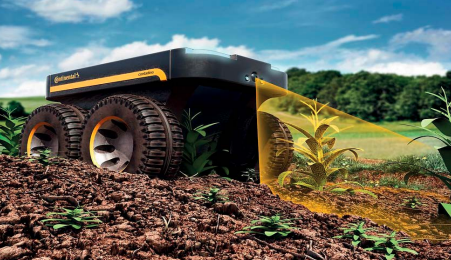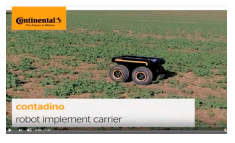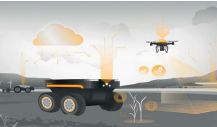We first saw this at Agritechnica 2019 when we met the team from Continental to understand their approach to providing agricultural robots to farmers

Continental believes the future may well rest with small driverless robots and the company has developed an advanced and flexible system. This approach as led to Contandino, a robot platform that could be used by anyone for anything in farming.

What can Contandio do out of the box? It is:
• Fully electric, fully autonomous
• Modular design allows exchangeable implements and different track widths
• Sensors data provide basis for safe autonomous driving and agricultural process
• Focus on agronomics: a light machine with big tyres (for it’s size) and high trafficability and low energy consumption
• Transported to the field in a trailer
• Can be sued in a swarm
• Equipped with lidar scanner, sonar radar, RTK GPS, camera and ultrasound for accurate row following
• Sustainable – no “local” emissions
• 48v Battery
• Wireless or Conductive charging – fast charging capability
• Cloud Communication • Onboard computing
• 3D Point Cloud, local obstacle detection.
• Wide angle camera – 360 degree view.
Here is a video which show a lot about what it can do: www.youtube. com/watch?v=XglpQYASXq0

As it stands, it can already record and photograph every plant in your field. But there are also drone solutions for this, so it isn’t revolutionary from that perspective. This is where Continental want to hand it over to other companies to develop agricultural solutions.
As Contadino is modular it can be used for different light duty tasks such as seeding, weeding, spraying, fertilizing, slug pelleting and monitoring. For these different purposes the robot can be equipped with different implements. The modular design allows for a maximum of flexibility regarding tool size and track width and enables a quick and easy maintenance. Continental have said that together with partners in the agricultural sector first applications will be developed and tested in 2020.
Digital Revolution
According to Hans-Jürgen Duensing, Continental Executive board member, the agricultural industry is undergoing a major transformation and digital and connected solutions are the fertilizer for efficient, safe and sustainable agriculture. Contadino offers solutions which meet exactly those requirements. The robots can work in fleet operation which means twenty robots can collaborate in one field. The fleet size can be flexibly configured. The transport to the field takes place with a trailer which also functions as charging and refill station for seeds, fertilizers, pellets and so on. This swarm concept guarantees an efficient and smooth workflow without any downtimes. Efficient electric motors and automatic recharging ensure a round-the-clockoperation. Contadino enables smart farming with precise application of pesticides and fertilizers or a selective sowing process.

Continental’s extensive experience in the field of autonomous driving and the sensor technology of Continental allow the realization of highest safety standards. The robot is equipped with lidar scanner, radar, RTK GPS, camera and ultrasound. These sensors ensure accurate object detection and classification, tracking and a GNSS accuracy of three centimetres. The tools are connected to the robot via open interfaces. This connection provides the implement with electric power and acts as a data line enabling access to sensor data and cloud communication.
One of the main principles that Contadino embodies is sustainability. The all-electric concept ensures no local emissions or soil contamination by leakages. Its low weight and small size result in low energy consumption and negligible soil compaction. It will be very interesting to see what the agricultural industry will develop off the back of this platform. Electric weed zapping, would seem an easy solution, although would maybe require a secondary battery. Spot spraying, maybe combined with Blue River technology that already exists and was written about in the last issue. The options are endless, when someone has already developed the robot that deals with the autonomous element.
And the price? We asked and were told it would be over £5,000 a unit. While not cheap, that same solution would cost hundreds of thousands to d e v e l o p m e n t independently, so offers the perfect solution to build upon.
